
The cidaas group management – delegated user administration quick and easy! For family & friends or B2B use cases.
The cidaas group management and the delegated user administration
The cidaas group management offers comprehensive options for grouping users, e.g., to map companies or company hierarchies, teams or even a family as a group. A user can be a member of several groups, e.g., a group for the company and a subgroup for a department or a team. In addition, users can be dynamically added and removed from groups via the cidaas APIs and the Admin UI, as well as the Group Admin UI created specifically for delegated administration. The Group Admin UI allows group administrators, e.g., the owner or manager of a company, or the parents in the context of a family, to manage their own group.
You can find more about cidaas group management in our documentation at: https://docs.cidaas.com/docs/cidaas-iam/3dedc10975884-group-admin-dashboard
B2B – Company Use Cases
For companies in the B2B environment, managing their own customers and the associated users is always a challenge and not only causes expenses for the company, but also often displeases more and more the customers. They expect a consistent customer experience that enables delegated user administration for self-administration of their own users. Using the example of “Auto GmbH” we show the cidaas group management in action:

In this case, the group represents “Auto GmbH” and is therefore the customer with whom there is a direct business relationship. This group consists of three employees who have different roles. Manfred Maier is the group administrator, for example the owner of Auto GmbH, and has the rights to edit and add his colleagues to the group. His two colleagues, Lisa Walter, and Dennis Schneider are users who do not have administrator rights.
In the next step, this group information can now be used by the customer systems to identify the company with which the logged-in user is associated. This means, for example, that order processes for end customers can be handled optimally without employees of a company having to share an account. Examples for the use of groups in B2B:
- Employees, as well as the owner of a medical practice, can place orders for medical products from the supplier in the name of the practice and also personalized.
- Those responsible at a retailer can manage their employees’ accounts independently (create, deactivate users, change roles, etc.) without having to go back to the company’s B2B support.
B2C – Family & Friends
In the Family & Friends scenario, we focus on cases in which a family or a group of friends is mapped using cidaas group management. A wide variety of use cases can be realized, e.g., account sharing with a streaming service in an intuitive and convenient way. Using the Schmidt family as an example, we will show you the advantages of this model.

As part of a streaming service, Marie Schmidt takes out a subscription for the entire family. Without cidaas group management, the email/password combination will often be used by the whole family, often called account sharing. However, this is discouraged, as sharing access data is not recommended for security reasons, even within the family.
With the group management, Marie Schmidt can invite her children, Max Schmidt, and Hanna Schmidt, with their own e-mail addresses or possibly usernames, so that they both have access to the family subscription with their own account. Within the group, Marie Schmidt has full control over who has access, which provides optimal rights control. This example shows how important a functioning group management is in combination with a UI for managing the users. Examples for the use of groups in the B2C or Family & Friends context. Examples of such B2C use cases are:
- Families can use the group to share a video streaming account within the family with different email addresses.
- Friends can use a joint stadium visit group to buy tickets within the same area.
